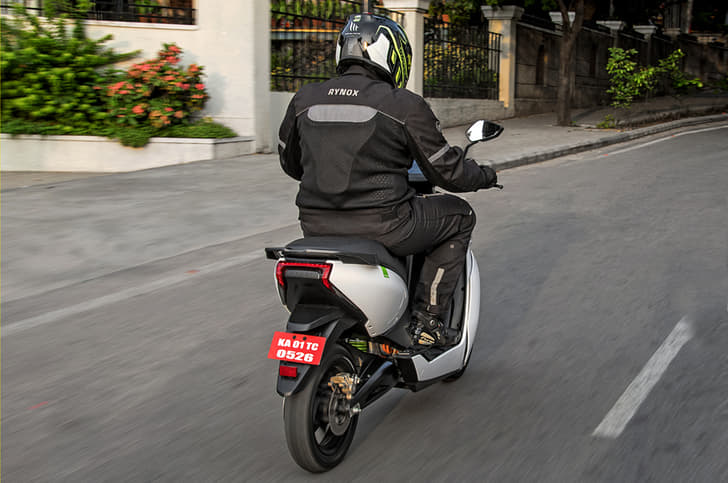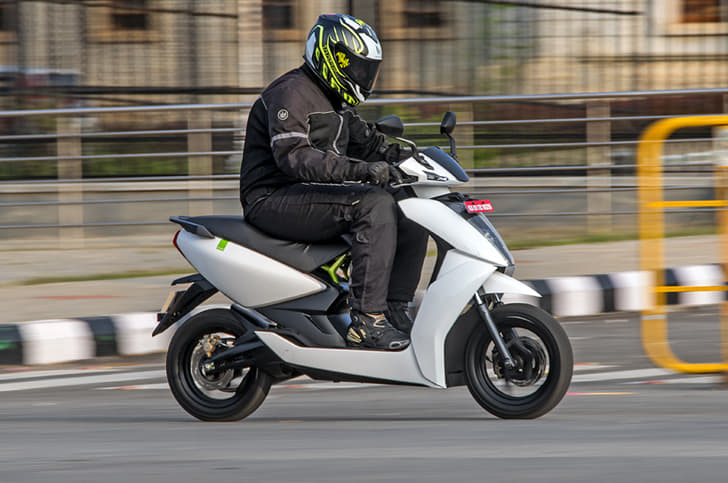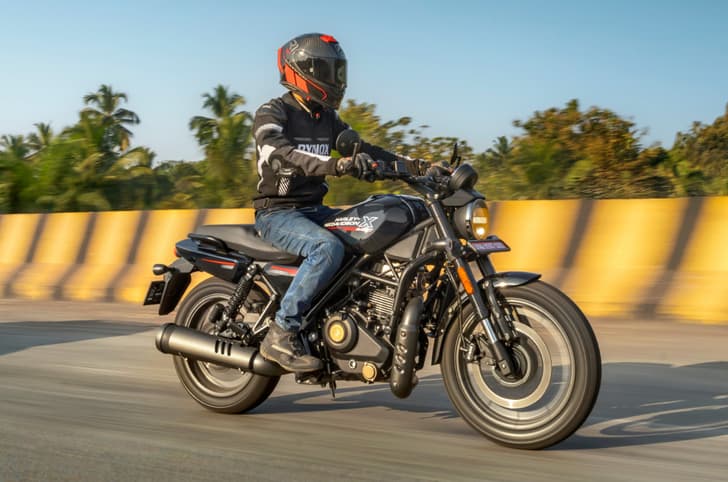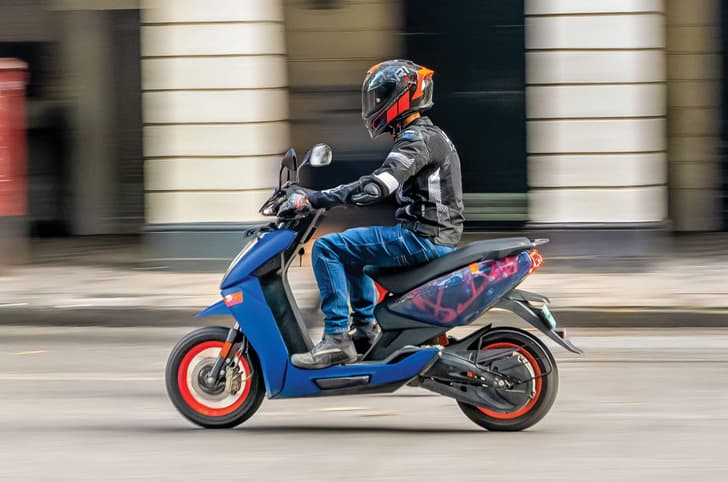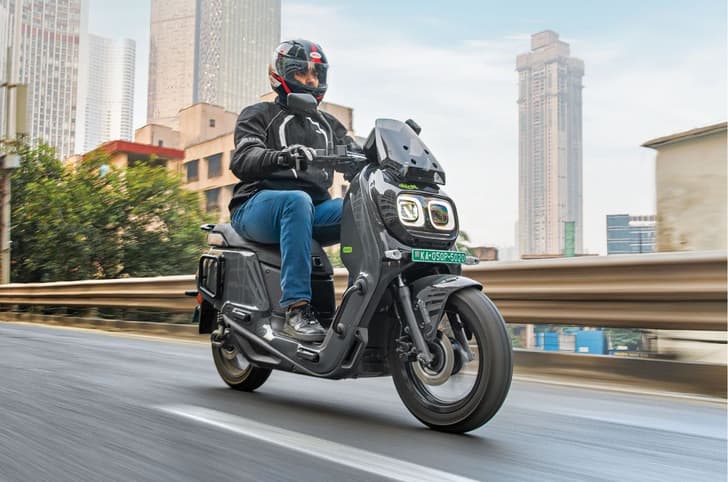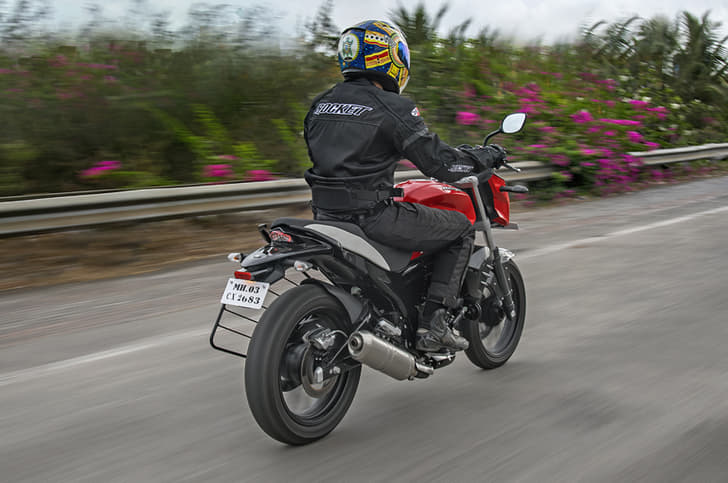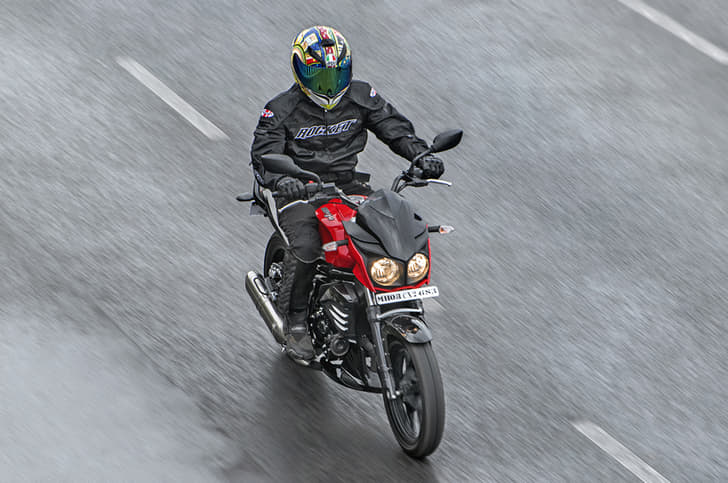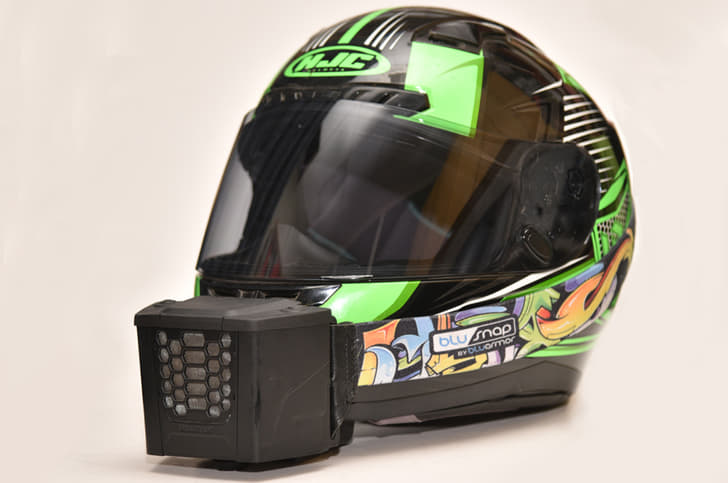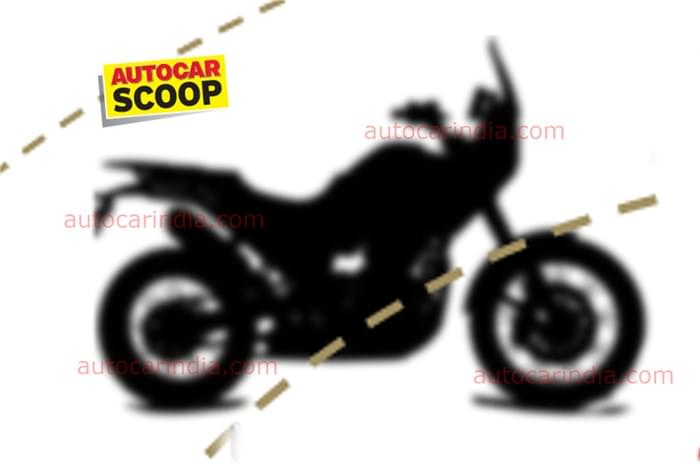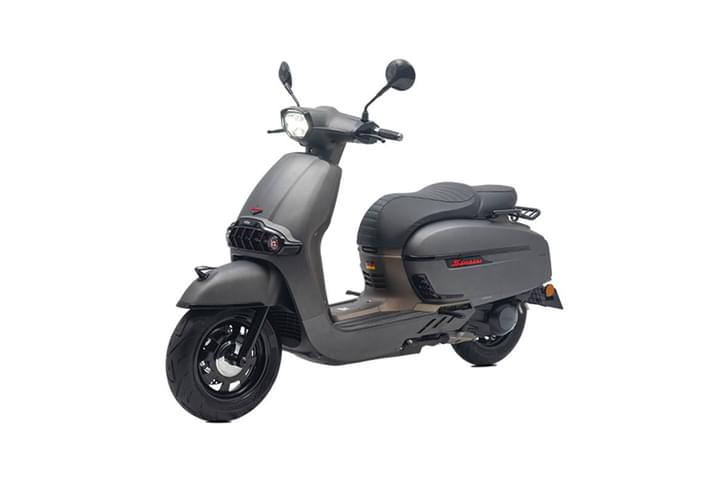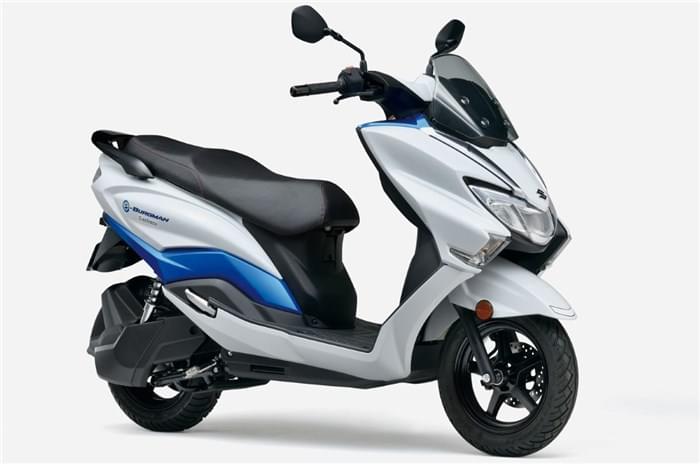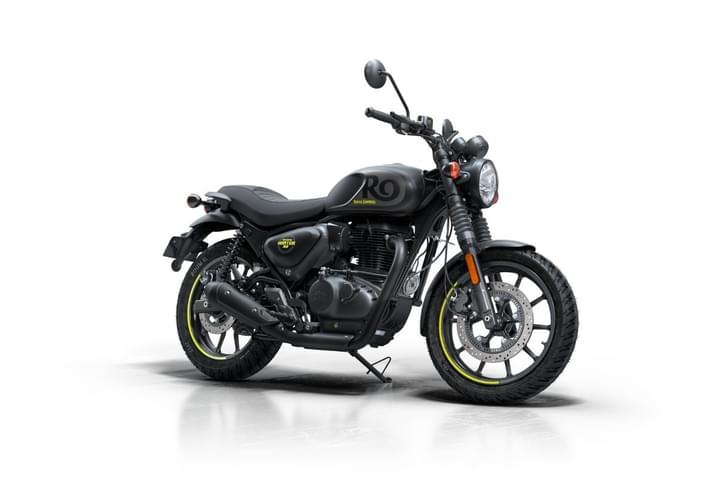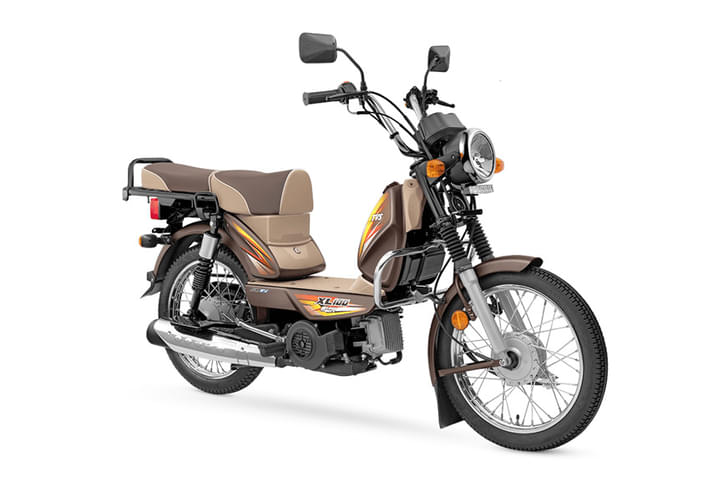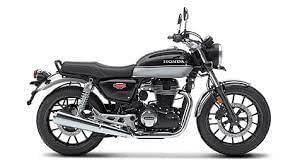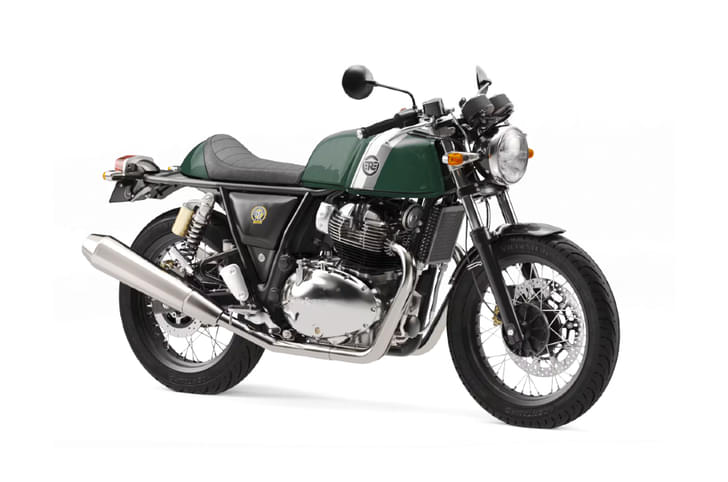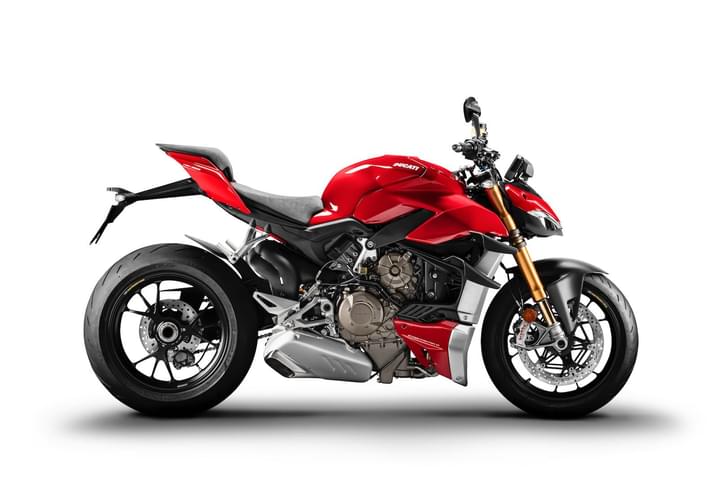Almost all of us exclude electric two-wheelers from our garages, and for similar reasons too. Range – the lack of it, thereof – is an obvious concern and so is the ordeal of charging. While these requirements may not be inflexible (some people really do commute just 10km a day, after all) there’s one aspect no rebuttal can tackle – real-world usability. The hapless inability of the current crop of electrics to keep pace with flowing traffic – we’ve all seen that awkwardly slow scooter hogging one lane – makes not wanting to join the tribe an effortless decision.
Indian start-up Ather Energy has been watching all of this with a deep interest from its sprawling glass-walled headquarters in the heart of Bengaluru. Its answer to this is the 340, a scooter we’ve seen in concept form for more or less the last four years. Except, late into the 340’s development, Ather realised it could do an even better all-round package, and thus was born – almost unintentionally – the 450. Though both of these scooters look identical and share their mechanicals, as well, there’s a noticeable performance gap between the two to justify both their existence. I’m riding the 450 today, going against the trend of saving the best for the end.
At the risk of giving too much away at the beginning, I will say this: unlike almost every electric-powered mode of transport, the Ather 450 isn’t the future of mobility. It is the present. That sounds like a boisterous claim, as the sceptics and trolls amongst you may believe, but having ridden Ather’s first production scooter, I see no reason to duck. And I see no reason to keep you waiting to read about the Ather 450’s real-world performance as well! So be it.
LOOKS PRETTY NORMAL
And that’s the point. The Ather 450’s design brief (or rather, its entire product brief) was to be ‘clean’. This applied not just in its tree-hugger approach to mobility but also in its overall appeal. The result is a scooter that blends well with your other worldly possessions, such as an Apple iPhone or a slick smartwatch. Its surfaces are simple and every bit of bodywork is painted a pure white, to amplify its clean outlook. This is the only colour you’ll be able to buy it in, for some time to come.
The 450 is clearly sporty but not outlandish, because Ather believes it has created a competitor to a conventional scooter – not an experimental alternative. As such, the 450’s design slots in between the blatantly sporty Aprilia SR range and the best-of-all-worlds TVS Ntorq. The full-LED headlight is a flush-fitting unit, mounted within the slim apron, and the tail-light (and turn-signal indicators) are also similarly snazzy LED units. On the flanks are two large floating panels that are neatly integrated. Viewed in profile, you will see the deliciously exposed bit of the trellis sub-frame under the rider’s seat, coated in an electric-green hue.
Another nice design touch are the skirts that run along the sides and end in a small step, which also serve as generous pillion footrests – your pillion won’t miss retractable foot pegs one bit. What stands out is the overall attention to detail, visible in the stylish number plate mounting at the front (it closely resembles a high quality aluminium alloy but isn’t), the impeccably finished mirror stalks and the generous and similarly well-finished grab rail.
Ather is firm on its stand towards practicality, and that reflects in, firstly, the roomy floorboard and, crucially, the underseat storage area. The latter is undoubtedly one of the most spacious in the business – and yes, it can accommodate a full-face helmet (we tried up to an LS2 and an MT – both size S – although Rishaad’s HJC was a little too big for it). The storage bay also has two small rubber-lined cavities on either side, and another neat touch is the elaborate LED light strip that offers a cool white glow and (naturally) illumination for the generously sized bay.
On the whole, the Ather 450 (and the 340, by virtue of being identical) is cool and doesn’t stray dramatically from the crop of conventional scooters. In other words, it chooses to be sporty and appealing without trying too hard to establish its identity (of being an electric scooter).
| Dimensions | |
|---|---|
| Ather 450 | |
| Length | 1800mm |
| Width | 700mm |
| Height | 1250mm |
| Wheelbase | 1278mm |
| Ground clearance | 160mm |
| Seat height | 765mm |
| Kerb weight | 118kg |
| Weight distribution (f:r) | 51:49 |
| Water Wading Limit | 300mm |
| Wheels | 12-inch |
| Tyres | 90/90-12 |
| Brake (f/r) | 200mm disc/190mm disc |
| Braking distance (60kph-0) | 28.6m |
| Suspension (f/r) | Telescopic fork/Progressive monoshock |
MAKING A DASH
Sorry, but you’ll have to wait some more before we get riding! This bit’s about the dashboard, or rather, what’s prominently housed within it. The large, 7.0-inch, full-colour capacitive touchscreen – definitely a first in the world of Indian scooters – forms the core of the Athers’ rider interface and you will be heavily dependent on it for practical purposes, amongst other cooler features. For those of you with raised eyebrows, Ather hasn’t committed a safety faux pas – touch functionality is only possible when the scooter is stationary.
Having said that, the touch responsiveness of the screen isn’t as intuitive as any average smartphone user would have liked. It requires light taps and offers inconsistent responses to gloved fingers (worked alright for me, but not quite for Rishaad). For a few functions, the two-direction scroll button on the right-hand side can be used and it proved to be helpful on at least one occasion, when I got a faster navigation route suggestion (sent from an Ather employee’s connected mobile, who was following in the tracking car) mid-ride. This meant I didn’t have to pull over to a stop to be able to respond to the screen prompt, saving me some time and inconvenience in a city I’m unfamiliar with. Now, most of us never take our scooters beyond familiar riding cycles (such as fixed commutes) so the emphasis on navigation may be overdone, but it shows the extent of Ather’s attention to getting the small things right, and that’s heartening.
The screen is an IP65 rated waterproof unit that offers a lot of other features as well, all of which can be controlled via a mobile app. The standard display features a speedometer, odometer, trip meter (time and distance), clock, average-speed indicator and an easy-to-spot readout for range (in km). The additional features are neatly positioned on three corners of the screen – a drop-down menu for settings and rider insights, one for navigation and the last (at the bottom) for the park assist feature. Park assist helps move the scooter in reverse, at a speed of 3kph, which is very helpful in tricky parking situations and also since the electric motor does create a bit of drag on the rear wheel, making it a bit difficult to push around naturally. The screen also features an Eco mode option that you can select to aid efficiency; it reduces top speed and response by a reasonable bit.
However, in its bid to make strong developmental leaps, Ather is constantly collecting location and riding style information from every scooter – this includes continuous GPS data (even if you aren’t using navigation) and each and every rider input, be it data related to acceleration, braking or cornering. A six-axis IMU (yes, the kind you see on superbikes), a gyroscope and full-time internet, thanks to a permanently-installed SIM card (Ather will pay for it initially and it will subsequently become part of a subscription service), makes this kind of data assimilation possible, in case you thought there was some sort of sorcery involved.
If your privacy is dear to you (for reasons you don’t have to disclose – ahem!), you can opt out of the system via an Incognito mode, but you have to remember to do so constantly, as the mode automatically turns off after 24 hours. A one-time selection feature would be much better and it’s an idea Ather isn’t opposed to at the moment. In any case, a naturally convenient by-product of any connected device (in this case, it’s a scooter) is the opportunity to receive over-the-air updates and this is something Ather is heavily counting on, in its quest to ensure the scooter only gets smarter with age. Fascinating!
IS SMARTER ANY GOOD ON THE ROAD?
My apologies to those who’ve endured the long read so far. Let’s ride! I’ve slipped into the 450’s reasonable perch (765mm seat height vs 766mm on the Grazia and 775mm on the SR125) and everything seems familiar as with any other sporty scooter I’ve ridden. With the key turned on, the kill switch disengaged and the starter thumbed, the 450’s motor comes to life. You don’t know it, of course, until you look at the screen because this is a completely noiseless procedure. You’d think sneaking out of home could have never been easier, but the scooter starts up with a loud chime that is certain to catch some attention
A gentle twist of the right wrist later, I wobbled out of the parking lot and into the real world. My very first 10 feet on an electric scooter were up a cobbled ramp – I’m not sure why I have to make this sound like a historic moment – and the 450 ascended it with nonchalant ease. I’ve read about the zero-rpm torque characteristics before, but experiencing it first hand is other-worldly.
Out on the delightfully empty early-morning streets of Bengaluru, I was prepared for a lull beyond 25kph but it never came. Instead, the 450 assumed its role of being a sporty scooter in an unbelievable instant. The dip in performance at 50kph – something I was sure would arrive – also never came. The 450 only got faster, and now emitted a rather likable whine all the way to an indicated 75kph (it had more to offer but we were within city limits). This was something I hadn’t expected and, therefore, couldn’t believe. The scooter felt – without an ounce of exaggeration – quicker than most scooters that I’ve ridden previously.
Pardon my old-school apprehensions, but it seemed to come across as more fun, too. The zero-lag performance translates to a proper point-and-squirt scooter, one you can out-accelerate most other small-displacement two-wheelers on. Of course, life on a scooter is beyond traffic light drag races and the Ather 450, thankfully, offers very usable power delivery. It has a strong mid-range, if not the strongest (although I suggest you wait for the numbers once we’ve tested it), and this makes overtaking a breeze. Interestingly, its performance isn’t hindered with a higher payload (in this case, a 75kg pillion) and it accelerates with nearly as much zest even under two-up riding. It certainly lacks the top-end performance of the quicker ones of the 125s and 150s, but the spirited in-city usability will seem like a fair compensation to many.
This staggering (in e-scooter terms) performance is courtesy of the lithium-ion battery pack and the 5.1kW brushless motor. The battery pack is built by Ather, which has also designed a bespoke (and smart) battery management system for it. The battery pack, mounted in an aluminium casing within the floorboard (for optimal centre of gravity), gets an IP67 water-resistance rating which means it can be submerged in up to a meter of water for half an hour without any adverse effects. The motor, meanwhile, is IP66-rated and is a frame-mounted unit, as opposed to the traditional choice of wheel hub-mounting, which offers stronger levels of performance. In effect, the battery pack sends charge to the electric motor, which then sends the power and torque to the rear wheel via a two-step reduction ratio and an exposed belt drive. This layout is not only simple but is also a very efficient way to minimise energy losses.
Under enthusiastic riding, Ather claims a realistic range of 75km in Eco mode and 60km in Power mode for the 450. This, despite having the opportunity to make tall claims, since ARAI’s tests produces a range of 107km! Just for this responsible and honest stance, it deserves a hearty round of applause. Oh, and for those of you disappointed with the range, Ather has focused instead on making charging easier and faster. Ather claims a 2hr 40min charging time to 80 percent capacity, 4hr 18min for a full charge and, under fast charging, 1km per minute. At present, fast charging will only be available at publicly installed chargers that are part of the Ather Grid. Initial customers will get the home charger (a cool-looking installation you wouldn’t mind flaunting) for free although it will later retail for under Rs 10,000.
Thankfully, Ather has been making efforts to set up a formidable charging structure alongside developing its two-scooter range, so all of its claims can be relished in the real world. It has already set up 14 charging stations in Bengaluru, with nearly 60 more planned just for 2018. The charging infrastructure isn’t thoughtless either, mind you. Ather’s target is to ensure you’re never more than 3km away from a charger, and just to get more people hooked to the concept, it has made its existing charging network accessible for free for six months. This applies to all EV owners and not just Ather customers, and that’s massively commendable. Ather aims to replicate this model in other cities without further delay, and Pune and Chennai are likely to get the Ather Grid next.
JUST FAST? OR FUN, TOO?
The city of Bengaluru set an ironical background for the Ather 450 test ride. This is two-stroke heaven and Jawas, RD350s and Shoguns aren’t uncommon out here. Most motorcycles here are heavily breathed upon and almost everyone knows a thing or two about popping wheelies. Astride the 450, I was up against enthusiastic traffic and there was no room or forgiveness for being caught napping. Again, the 450 didn’t disappoint.
The aluminium-and-steel hybrid, machined frame is a sight to behold when stripped off its bodywork, and it performs as impressively as its looks suggest. It boasts lightweight construction – the aluminium swingarm weighs 4.2 kg, the rear subframe, 3.5kg! – and this helps keep the scooters total (kerb) weight down to a decent 118kg. This, and being shod with 12-inch wheels (90/90 R12s at both ends), translates to very likeable urban dynamics.
The 450 has electric responses (sorry, couldn’t resist!) and its flickability matches its straight-line perkiness. It gets a telescopic fork and a centrally-mounted, non-adjustable monoshock, and the ride quality is clearly biased more towards ‘sporty’ than ‘comfy’. The firm-ish ride isn’t disturbingly so, and it does get pliant with a pillion on-board, but its not the most comfy in the business.
One of the highlights of the 450 is that it sports a disc brake at both ends and also features (and is required by law to have) a hydraulic combined braking system activated by the rear brake lever. Overall braking performance is impressive although the front brake feels a little dull; the rear, under hard braking, locks up easily. The 450 also features regenerative braking (although it’s set to a very mild tune) and you don’t really notice it for the most part.
| Powertrain | ||
|---|---|---|
| Ather 340 | Ather 450 | |
| Power | 4.4kW | 5.4kW |
| Torque | 20Nm | 20.5Nm |
| Top speed | 70kph | 80kph |
| Acceleration (0-40 kmph) | 5.1s | 3.9s |
| Range (Eco-mode on) | 60km | 75km |
| Range (Eco-mode off) | 50km | 60km |
| Range (ARAI) | 86km | 107km |
| Battery capacity` | 1.92kWh | 2.4kWh |
| Battery type | Lithium-ion | Lithium-ion |
| 0-80% (Home charging) | 2 hours 40 minutes | |
| 0-100% (Home charging) | 4 hours 18 minutes | |
| Fast-charging rate | 1 km/min | |
SHOULD YOU BUY ONE?
With petrol prices soaring, there hasn’t been a stronger incentive to buy an electric scooter. But buying a scooter itself emerges from a greater concern than mere economy. You need a scooter because it’s convenient, practical and effortless. Can the Ather 450 prove so? The traditionalist in me hates to admit it, but it does – easily, that too.
The Ather 450 feels equivalent to a 125cc scooter on most counts (top speed being the only exception) and, in terms of what it offers – the cool quotient and its meticulously incorporated features – it makes a strong case for itself. It’s realistic and practical, and as an overall effort, is miles ahead in terms of being a convincing electric scooter you can (almost) blindly replace your petrol-sipping scooter with. Almost, because Ather is yet to prove its long-term dependability as a manufacturer and because it remains to be seen whether it can establish its supporting infrastructure with as much zest across the country as it has in Bengaluru.
Finally, the prices. Priced at Rs 1,24,750 (on-road, Bengaluru), the Ather 450 is obviously far from cheap, but it’s a justifiable price point given all that on offer, and especially so for those interested in being early adopters of new technology. Like with any technological leap, prices do eventually descend to reasonable points (mobile phones, for example) with an increase in sales, but that point is set well into the future, something Ather itself isn’t heavily concerned with at the moment. The price tag may be steep (but not unjustifiably so) but what it fetches you is more than just a good scooter, electric or not. You buy into an accomplishment, a movement, and it’s finally a good time to join the party.


